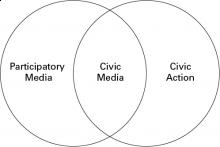“You should take Sasha’s class, Intro to Civic Media.”
It started with a suggestion from Nathan Matias, a research assistant from the Center for Civic Media. I was sitting in Starbucks right off MIT’s campus, hearing about his projects and talking about potential projects I could work on for a senior project that I’d have to complete in the spring. As a computer science major with an interest in journalism, the future of news, and the intersection of journalism and technology, I wanted to work on a senior project that would meld my two interests together to create a tool that journalists and newsrooms would find useful.
I thought about his suggestion, looked up the course, and thought it looked interesting. It briefly crossed my mind that I didn’t really know a concrete definition for civic media, but since it had the word “intro to” preceding it in the course name, I figured I’d learn about it during the course. I took a guess by taking the words “civic” and “media,” defining them separately, and then combining them back together to get a definition along the lines of “the study of communications within and among communities.”
After the first class, I realize my definition probably wasn’t wrong per se, but definitely too shallow to be useful. As a class, we came up with seven principles of civic media:
• Civic media aspires to be participatory.
• Civic media promotes action and engagement.
• Civic media fights against social inequality.
• Civic media reflects the community it comes from.
• Civic media is accessible.
• Civic media challenges people to rethink social structures.
• Civic media fosters transparency and accountability.
We also got this Venn diagram:

My loose definition of civic media had captured part of the participatory media circle, but none of the civic action circle.
Out of the seven principles, the ones that I find to be most intriguing are that civic media aspires to be participatory, reflects the community it comes from, and is accessible (unsurprisingly enough, they all fall into the participatory media circle).
1. Civic media aspires to be participatory: Civic media is engaging and pushes for community participation. One example of participatory media that also fosters transparency and accountability, as well as most other points from our list of seven principles, is Homicide Watch DC, a “community-driven reporting project covering every murder in the District of Columbia” whose motto is “Mark every death. Remember every victim. Follow every case.”
2. Civic media is accessible: Civic media is accessible to the participants as well as the audience. One of my favorite examples of civic media and it’s emphasis on the global community is Global Voices, which is a collection of blogs from bloggers around the world. What is so unique about this collection is that the blogs are translated into more than 30 languages so that stories can cross language barriers.
3. Civic media reflects the community it comes from: Because civic media aspires to be participatory and accessible, civic media also reflects the community it comes from. One example is Patch, which is community-driven and appears to bridge traditional journalism with participatory media.
Something I’d like to get a better feel for by the end of the semester is where traditional journalism currently stands in the civic media Venn diagram and whether it is shifting as social media invades the media space. And since the idea of measuring success in journalism has been a recent discussion, I am also interested in learning about different ways that success in the broader category of civic media can be measured (if that’s even possible).
I’m excited to be in this class, and I’m looking forward to sharing my notes and thoughts here on this blog this semester!

